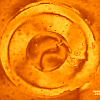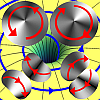Research in Soft Matter
We focus on different soft matter, either interfacial or bulk, systems. Langmuir films and self-assembling monolayers are currently investigated as prototypical examples of two-dimensional soft matter condensates. Our main interest covers different non-equilibrium situations and particularly we look on the effects of different flow conditions or imposed shear flows. Special attention is devoted to chiral selection scenarios in Langmuir monolayers. Colloidal systems are also studied, and singularly we consider chemically functionalized, anisometric or magnetically active colloids when dispersed either in aqueous solutions or in anisotropic elastic matrices (colloidal nematics). Finally liquid crystals, nematic or smectics are also investigated mostly in relation to the behavior of their orientational textures when confined under patterned substrates. Below you can find information on our current research interests.Active Soft Matter

Active soft matter is a new paradigm that can be considered as an extension of traditional soft materials where dynamic self-assembly emerges through the consumption of stored or ambient free-energy. For example, active gels can be obtained by a suitable combination of cytoskeleton proteins.
Colloids in complex fluids

Colloidal particles dispersed in liquid crystals results in a diversity of self-assembled structures, such as linear chains or anisotropic clusters. In their turn, micro-inclusions can perturb the liquid crystal matrix thus enabling new control strategies. For instance, paramagnetic anisometric inclusions can be employed to reorient a nematic mesophase.
Liquid crystal alignment on soft ordered films

The long-range orientation of liquid crystals is very sensitive on the boundary conditions when in confined geometries. Typically, uniform polymer or surfactant films or patterned polymer layers are employed to impose liquid crystal anchoring. We study the patterning of nematic and cholesteric liquid crystal cells through contact with Langmuir-Blodgett films.
Functional Self-Assembled Monolayers

Self-assembling monolayers (SAM's) are obtained by direct adsorption/reaction of an adsorbate on a given solid support. In this way, and compared to Langmuir-Blodgett films, we gain stability for the monolayers formed but we loose control on the final structure of the monolayer.
Chiral control in Soft Monolayers

The formation of chiral structures in Langmuir monolayers can take place starting from chiral or achiral amphiphilic molecules. In this last case, the influence of chiral forces of different strength and nature, physical or chemical, is essential to select and control the handedness of the monolayer.
